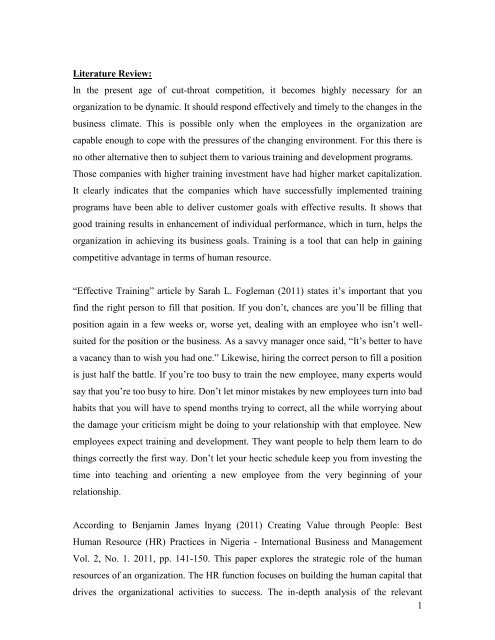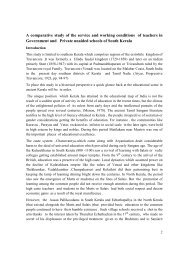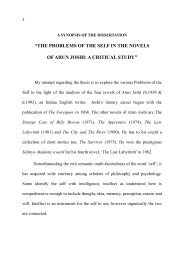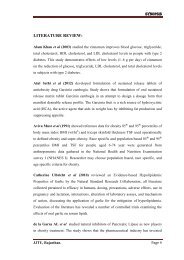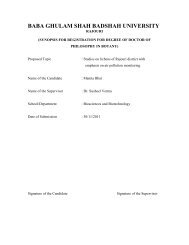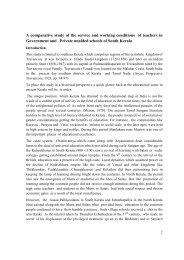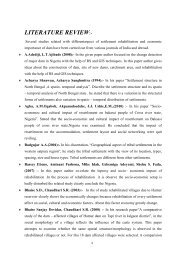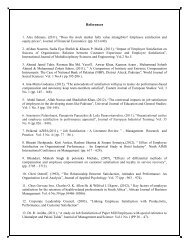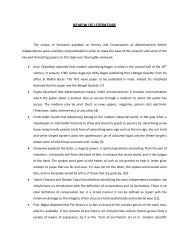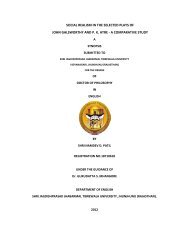1 Literature Review: In the present age of cut-throat competition, it ...
1 Literature Review: In the present age of cut-throat competition, it ...
1 Literature Review: In the present age of cut-throat competition, it ...
Create successful ePaper yourself
Turn your PDF publications into a flip-book with our unique Google optimized e-Paper software.
<strong>L<strong>it</strong>erature</strong> <strong>Review</strong>:<br />
<strong>In</strong> <strong>the</strong> <strong>present</strong> <strong>age</strong> <strong>of</strong> <strong>cut</strong>-<strong>throat</strong> <strong>compet<strong>it</strong>ion</strong>, <strong>it</strong> becomes highly necessary for an<br />
organization to be dynamic. It should respond effectively and timely to <strong>the</strong> changes in <strong>the</strong><br />
business climate. This is possible only when <strong>the</strong> employees in <strong>the</strong> organization are<br />
capable enough to cope w<strong>it</strong>h <strong>the</strong> pressures <strong>of</strong> <strong>the</strong> changing environment. For this <strong>the</strong>re is<br />
no o<strong>the</strong>r alternative <strong>the</strong>n to subject <strong>the</strong>m to various training and development programs.<br />
Those companies w<strong>it</strong>h higher training investment have had higher market cap<strong>it</strong>alization.<br />
It clearly indicates that <strong>the</strong> companies which have successfully implemented training<br />
programs have been able to deliver customer goals w<strong>it</strong>h effective results. It shows that<br />
good training results in enhancement <strong>of</strong> individual performance, which in turn, helps <strong>the</strong><br />
organization in achieving <strong>it</strong>s business goals. Training is a tool that can help in gaining<br />
compet<strong>it</strong>ive advant<strong>age</strong> in terms <strong>of</strong> human resource.<br />
“Effective Training” article by Sarah L. Fogleman (2011) states <strong>it</strong>‟s important that you<br />
find <strong>the</strong> right person to fill that pos<strong>it</strong>ion. If you don‟t, chances are you‟ll be filling that<br />
pos<strong>it</strong>ion again in a few weeks or, worse yet, dealing w<strong>it</strong>h an employee who isn‟t well-<br />
su<strong>it</strong>ed for <strong>the</strong> pos<strong>it</strong>ion or <strong>the</strong> business. As a savvy man<strong>age</strong>r once said, “It‟s better to have<br />
a vacancy than to wish you had one.” Likewise, hiring <strong>the</strong> correct person to fill a pos<strong>it</strong>ion<br />
is just half <strong>the</strong> battle. If you‟re too busy to train <strong>the</strong> new employee, many experts would<br />
say that you‟re too busy to hire. Don‟t let minor mistakes by new employees turn into bad<br />
hab<strong>it</strong>s that you will have to spend months trying to correct, all <strong>the</strong> while worrying about<br />
<strong>the</strong> dam<strong>age</strong> your cr<strong>it</strong>icism might be doing to your relationship w<strong>it</strong>h that employee. New<br />
employees expect training and development. They want people to help <strong>the</strong>m learn to do<br />
things correctly <strong>the</strong> first way. Don‟t let your hectic schedule keep you from investing <strong>the</strong><br />
time into teaching and orienting a new employee from <strong>the</strong> very beginning <strong>of</strong> your<br />
relationship.<br />
According to Benjamin James <strong>In</strong>yang (2011) Creating Value through People: Best<br />
Human Resource (HR) Practices in Nigeria - <strong>In</strong>ternational Business and Man<strong>age</strong>ment<br />
Vol. 2, No. 1. 2011, pp. 141-150. This paper explores <strong>the</strong> strategic role <strong>of</strong> <strong>the</strong> human<br />
resources <strong>of</strong> an organization. The HR function focuses on building <strong>the</strong> human cap<strong>it</strong>al that<br />
drives <strong>the</strong> organizational activ<strong>it</strong>ies to success. The in-depth analysis <strong>of</strong> <strong>the</strong> relevant<br />
1
l<strong>it</strong>erature shows that <strong>the</strong> workforce that is properly and continuously trained and<br />
developed through effective capac<strong>it</strong>y building lever<strong>age</strong>s <strong>the</strong> organization to achieve a<br />
compet<strong>it</strong>ive advant<strong>age</strong> and <strong>the</strong> bottom line. The human resource man<strong>age</strong>ment function,<br />
essentially concerned w<strong>it</strong>h all matters related to employment relationships in <strong>the</strong><br />
organization – that is, attracting, developing, motivating and maintaining a vibrant<br />
workforce – must be handled dutifully in strategic partnership w<strong>it</strong>h <strong>the</strong> HR pr<strong>of</strong>essional.<br />
The paper recommends <strong>the</strong> HR strategies and practices that mangers can adopt to drive<br />
optimum value from employees, and <strong>the</strong>se range from proper selection <strong>of</strong> <strong>the</strong> right people<br />
through employee empowerment, capac<strong>it</strong>y building, employee motivation to improved<br />
organizational rewards.<br />
According to <strong>In</strong>gunn Hybertsen Lysø, Kristian Mjøen and Morten Levin (2011) in <strong>the</strong>ir<br />
article “Using collaborative action learning projects to increase <strong>the</strong> impact <strong>of</strong><br />
Man<strong>age</strong>ment development”- <strong>In</strong>ternational Journal <strong>of</strong> Training and Development 15:3 –<br />
2011 Blackwell Publishing Ltd. mentioned that <strong>the</strong>ir article aims to contribute to <strong>the</strong> field<br />
<strong>of</strong> human resource development by exploring <strong>the</strong> cond<strong>it</strong>ions that influence <strong>the</strong><br />
organizational impact <strong>of</strong> action learning projects. Many organizations use such projects<br />
as an integral part <strong>of</strong> <strong>the</strong>ir man<strong>age</strong>ment development programs. Past research on action<br />
learning projects has shown how balancing action and learning improves <strong>the</strong><br />
organizational impact <strong>of</strong> man<strong>age</strong>ment development.<br />
Enhancing Employees‟ Comm<strong>it</strong>ment to Organisation through Training - <strong>In</strong>ternational<br />
Journal <strong>of</strong> Business and Man<strong>age</strong>ment Vol. 6, No. 7; July 2011 – by Owoyemi,<br />
Oluwakemi Ayodeji, Oyelere, Michael, and Elegbede, Tunde (2011) <strong>the</strong>y state that <strong>the</strong><br />
role <strong>of</strong> training in human resource man<strong>age</strong>ment practice has spur renewed and vigorous<br />
debate about <strong>the</strong> need for training and development. The debate has led academics and<br />
man<strong>age</strong>ment to ponder on some issues germane to <strong>the</strong> benef<strong>it</strong>s or o<strong>the</strong>rwise <strong>of</strong> training. Is<br />
training an investment in people or cost? If training is required, what are <strong>the</strong> cr<strong>it</strong>erion<br />
used to determine who should be trained and when to train? These questions have<br />
permeated man<strong>age</strong>ment circle and those in HRM department. Recent years have seen<br />
training terms renamed as training and development or learning and development, a sign<br />
<strong>of</strong> <strong>the</strong> spate <strong>of</strong> debate on <strong>the</strong> issue. Given <strong>the</strong>se flurry, this paper explores <strong>the</strong> relationship<br />
between training and employees‟ comm<strong>it</strong>ment to <strong>the</strong>ir organisation. A regression analysis<br />
was conducted on <strong>the</strong> data collected. The study revealed a pos<strong>it</strong>ive statistical significant<br />
2
elationship between <strong>the</strong> different levels <strong>of</strong> training and employees‟ comm<strong>it</strong>ment to <strong>the</strong><br />
organisation. The paper concludes that <strong>the</strong> more <strong>the</strong> training giving to employees, <strong>the</strong><br />
higher <strong>the</strong>ir level comm<strong>it</strong>ment to <strong>the</strong> organization.<br />
Sulu Baba<strong>it</strong>a ISIAKA (2011) in <strong>the</strong> study - Motives for Training and Man<strong>age</strong>ment<br />
Development in <strong>the</strong> Nigerian Banking <strong>In</strong>dustry - Asian Social Science Vol. 7, No. 3;<br />
March 2011 focused on <strong>the</strong> motives for training and man<strong>age</strong>ment development using <strong>the</strong><br />
Nigerian Banking <strong>In</strong>dustry as a case study .The study relied on both qual<strong>it</strong>ative and<br />
quant<strong>it</strong>ative analysis <strong>of</strong> data. The results <strong>of</strong> <strong>the</strong> analysis showed that banks see training<br />
and man<strong>age</strong>ment development as important factors, as well having motives for investing<br />
in Training and man<strong>age</strong>ment development. These motives include- new technology;<br />
productiv<strong>it</strong>y; responding to skills deficiencies; moral duty; new hire request; and staff<br />
request. Some <strong>of</strong> <strong>the</strong> recommendations based on <strong>the</strong> findings include- training should be<br />
seen as one <strong>of</strong> <strong>the</strong> most important strategies for organizations to help employees gain<br />
proper knowledge and skills needed to meet <strong>the</strong> environmental challenges; <strong>it</strong> must also be<br />
noted that, training and development, though primarily concerned w<strong>it</strong>h people, is also<br />
concerned w<strong>it</strong>h technology, <strong>the</strong> precise way an organization does business.<br />
<strong>In</strong> <strong>the</strong> study by Jay Liebow<strong>it</strong>z, (2010) on The Role <strong>of</strong> HR in Achieving a Sustainabil<strong>it</strong>y<br />
Culture - Journal <strong>of</strong> Sustainable Development Vol. 3, No. 4; December 2010 An<br />
organization‟s Human Resource function can be instrumental in facil<strong>it</strong>ating a<br />
comprehensive approach for creating a culture <strong>of</strong> sustainabil<strong>it</strong>y and environmental<br />
stewardship. As such, <strong>it</strong> is recommended that an organization‟s Sustainabil<strong>it</strong>y<br />
Coordinator work more closely w<strong>it</strong>h <strong>the</strong> organization‟s Human Resource exe<strong>cut</strong>ive. This<br />
idea might be considered a new area <strong>of</strong> focus for <strong>the</strong> practical implementation <strong>of</strong><br />
sustainable development in a company. The strategy involves making significant changes<br />
to <strong>the</strong> organization‟s systems for: recru<strong>it</strong>ing applicants, selecting new employees,<br />
conducting new employee orientation, conducting performance evaluations, determining<br />
employee compensation, creating a succession planning process, providing employees<br />
w<strong>it</strong>h training and development, and mentoring employees and man<strong>age</strong>rs. It also involves<br />
creating a win-win-win collaboration among multiple stakeholders who are in conflict<br />
w<strong>it</strong>h each o<strong>the</strong>r. Numerous examples are provided demonstrating how a focus on each <strong>of</strong><br />
<strong>the</strong> HR systems has helped organizations to create a sustainabil<strong>it</strong>y culture.<br />
3
According to Kurt Kraiger (2010) -An Empirical Evaluation <strong>of</strong> Three Popular Training<br />
Programs to Improve <strong>In</strong>terpersonal Skills - Journal <strong>of</strong> Psychological Issues in<br />
Organizational Culture, Volume 1, Number 1, 2010. Multiple measures are available to<br />
aid in <strong>the</strong> analysis, interpretation, and use <strong>of</strong> interpersonal style when interacting w<strong>it</strong>h<br />
o<strong>the</strong>rs. To be maximally effective, interpersonal skills training should be logically linked<br />
to <strong>the</strong> assessment instruments, and training should provide not only information about <strong>the</strong><br />
assessment instrument but also <strong>the</strong> knowledge and skills associated w<strong>it</strong>h using <strong>the</strong><br />
instrument effectively to analyze and respond to <strong>the</strong> behavior <strong>of</strong> o<strong>the</strong>rs. Effective training<br />
evaluation requires multiple measures conforming to <strong>the</strong> objectives <strong>of</strong> <strong>the</strong> training. The<br />
evaluations focused on:<br />
• Trainee reactions, that is, <strong>the</strong> extent to which participants enjoyed <strong>the</strong> training and<br />
perceived <strong>the</strong> training as useful for diagnosing <strong>the</strong> behaviors <strong>of</strong> o<strong>the</strong>rs and<br />
communicating effectively w<strong>it</strong>h <strong>the</strong>m<br />
• Participants‟ knowledge <strong>of</strong> key concepts covered in training<br />
• Participants‟ skills at applying what <strong>the</strong>y learned by correctly analyzing <strong>the</strong><br />
interpersonal styles <strong>of</strong> how <strong>the</strong>y would act toward o<strong>the</strong>r characters given knowledge <strong>of</strong><br />
<strong>the</strong>ir styles or pr<strong>of</strong>iles.<br />
Regardless <strong>of</strong> what participants remember from <strong>the</strong> training, <strong>it</strong> is important that <strong>the</strong>y be<br />
able to use <strong>the</strong> training to analyze and respond to <strong>the</strong> interpersonal behaviors <strong>of</strong> o<strong>the</strong>rs.<br />
Nguyen Ngoc Thang, Truong Quang & Dirk Buyens (2010) - The Relationship Between<br />
Training and Firm Performance - This research interests include human resources<br />
man<strong>age</strong>ment, training and development, employee and firm performance, and <strong>the</strong> labour<br />
market. This is a study on human resource training and <strong>it</strong>s effect on firm performance,<br />
and <strong>it</strong> developed and proposed a framework for analysing training and firm performance<br />
issues in order to assess <strong>the</strong> advant<strong>age</strong>s and disadvant<strong>age</strong>s <strong>of</strong> many previous studies (e.g.,<br />
research design, measurement <strong>of</strong> variables and firm performance or estimation method.<br />
There were two approaches to gauge <strong>the</strong> impact <strong>of</strong> training on firm performance, namely<br />
<strong>the</strong> studies that use firm level data from a large sample <strong>of</strong> firms and <strong>the</strong> case study<br />
approach. Based on <strong>the</strong> firm performance measures used in previous studies firm<br />
performance was classified into financial firm performance and non financial firm<br />
performance. The review <strong>of</strong>fers new directions for future research that has potential to<br />
4
guide pract<strong>it</strong>ioners and man<strong>age</strong>rs to decide on <strong>the</strong>ir human cap<strong>it</strong>al investment plans and<br />
provide training for <strong>the</strong>ir employees.<br />
The program l<strong>it</strong>erature on Supervisor‟s Role as an Antecedent <strong>of</strong> Training Transfer and<br />
Motivation to Learn in Training Programs by Azman Ismail, Hasan Al Banna Mohamed<br />
Ahmad Zaidi Sulaiman Suriawati Sabhi, (2010) Training and development program<br />
l<strong>it</strong>erature highlights two major characteristics <strong>of</strong> supervisor‟s role: support and<br />
communication. The abil<strong>it</strong>y <strong>of</strong> supervisors to provide adequate support and practice good<br />
communication style in relation to training programs may lead to increased training<br />
transfer and motivation to learn. Though <strong>the</strong> nature <strong>of</strong> this relationship is significant, l<strong>it</strong>tle<br />
is known about <strong>the</strong> predictive properties <strong>of</strong> supervisor‟s roles in training program<br />
l<strong>it</strong>eratures. Fur<strong>the</strong>r, <strong>the</strong> outcomes <strong>of</strong> stepwise regression analysis showed four important<br />
findings: first, support insignificantly correlated w<strong>it</strong>h motivation to learn. Second,<br />
communication significantly correlated w<strong>it</strong>h motivation to learn. Third, support<br />
significantly correlated w<strong>it</strong>h transfer <strong>of</strong> training. Finally, communication significantly<br />
correlated w<strong>it</strong>h transfer <strong>of</strong> learning. Statistically, this result confirms that support is an<br />
important antecedent <strong>of</strong> motivation to learn and communication is an important<br />
antecedent <strong>of</strong> motivation to learn. Conversely, support and communication are important<br />
antecedents <strong>of</strong> training transfer in <strong>the</strong> studied organization. <strong>In</strong> add<strong>it</strong>ion, discussion,<br />
implications and conclusion are elaborated.<br />
Anjali Ghanekar (2009) Essentials <strong>of</strong> Training and Development – Clarifies <strong>the</strong> strategic<br />
role <strong>of</strong> training and development in Human Resource Man<strong>age</strong>ment. The focus <strong>of</strong> training<br />
and development goes beyond <strong>the</strong> immediate requirements <strong>of</strong> <strong>the</strong> job. The development<br />
programs must have a long term perspective and must meet <strong>the</strong> needs <strong>of</strong> <strong>the</strong> organisation<br />
in four major areas; human resource planning, organizational adaptation and<br />
improvement, organizational culture and climate and organizational effectiveness. It<br />
focuses on aligning training and development to business strategies. Needs assessment,<br />
training design and delivery methods and training evaluation and career planning <strong>of</strong><br />
employees and employee development are properly explained. Thus <strong>it</strong> provides <strong>the</strong><br />
essentials <strong>of</strong> training and development in organizational settings.<br />
5
Herman Aguinis and Kurt Kraiger (2009) (Benef<strong>it</strong>s <strong>of</strong> Training and Development for<br />
<strong>In</strong>dividuals and Teams, Organizations, and Society - Annu. Rev. Psychol. 2009. 60:451–<br />
74 – Volume 60, 2009) believe that training in work organizations is an area <strong>of</strong> applied<br />
psychological research that is particularly well su<strong>it</strong>ed for making a clear contribution to<br />
<strong>the</strong> enhancement <strong>of</strong> human well-being and performance in organizational and work<br />
settings as well as in society in general. This article provides a review <strong>of</strong> <strong>the</strong> training and<br />
development l<strong>it</strong>erature since <strong>the</strong> year 2000. The l<strong>it</strong>erature review focuses on <strong>the</strong> benef<strong>it</strong>s<br />
<strong>of</strong> training and development for individuals and teams, organizations, and society. How<br />
<strong>the</strong>y have adopted a multidisciplinary, multilevel, and global perspective to demonstrate<br />
that training and development activ<strong>it</strong>ies in work organizations can produce important<br />
benef<strong>it</strong>s for each <strong>of</strong> <strong>the</strong>se stakeholders. It also reviews <strong>the</strong> l<strong>it</strong>erature on needs assessment<br />
and pertaining states, training design and delivery, training evaluation, and transfer <strong>of</strong><br />
training to identify <strong>the</strong> cond<strong>it</strong>ions under which <strong>the</strong> benef<strong>it</strong>s <strong>of</strong> training and development<br />
are maximized. Many studies have ga<strong>the</strong>red support for <strong>the</strong> benef<strong>it</strong>s <strong>of</strong> training for<br />
organizations as a whole. These benef<strong>it</strong>s include improved organizational performance<br />
(e.g., pr<strong>of</strong><strong>it</strong>abil<strong>it</strong>y, effectiveness, productiv<strong>it</strong>y, operating revenue per employee) as well as<br />
o<strong>the</strong>r outcomes that relate directly (e.g., reduced costs, improved qual<strong>it</strong>y and quant<strong>it</strong>y) or<br />
indirectly (e.g., employee turnover, organization‟s reputation, social cap<strong>it</strong>al) to<br />
performance.<br />
An Article by Haslinda ABDULLA (2009) - Major Challenges to <strong>the</strong> Effective<br />
Man<strong>age</strong>ment <strong>of</strong> Human Resource Training and Development Activ<strong>it</strong>ies - The Journal <strong>of</strong><br />
<strong>In</strong>ternational Social Research Volume 2 / 8 Summer 2009. He mentioned Human<br />
resource training and development (HR T&D) in manufacturing firms is a cr<strong>it</strong>ical aspect<br />
<strong>of</strong> <strong>the</strong> development <strong>of</strong> a knowledge-workforce in Malaysia. The objective <strong>of</strong> this study is<br />
to examine challenges to <strong>the</strong> effective man<strong>age</strong>ment <strong>of</strong> HR T&D activ<strong>it</strong>ies in<br />
manufacturing firms in Malaysia. <strong>In</strong> order to achieve this objective, in-depth interviews<br />
were conducted w<strong>it</strong>h 58 HR man<strong>age</strong>rs managing employees‟ training and development,<br />
employing a purposive or judgmental sampling technique. The study revealed three major<br />
challenges to <strong>the</strong> effective man<strong>age</strong>ment <strong>of</strong> HR T&D. These include a short<strong>age</strong> <strong>of</strong><br />
intellectual HRD pr<strong>of</strong>essionals to man<strong>age</strong> HR T&D activ<strong>it</strong>ies, coping w<strong>it</strong>h <strong>the</strong> demand<br />
for knowledge workers and fostering learning and development in <strong>the</strong> workplace. It is<br />
hoped that <strong>the</strong> findings <strong>of</strong> this study will provide HR pr<strong>of</strong>essionals w<strong>it</strong>h a clear<br />
6
understanding and awareness <strong>of</strong> <strong>the</strong> various challenges in managing effective HR training<br />
and development. Hence, relevant and appropriate policies and procedures can be<br />
developed and implemented for an effective man<strong>age</strong>ment <strong>of</strong> HR T&D.<br />
C.B. Mamoria & S.V. Gankar (2008) Personnel Man<strong>age</strong>ment<br />
Every organization needs to have well trained and experienced people to perform <strong>the</strong><br />
activ<strong>it</strong>ies that have to be been done. It is necessary to increase <strong>the</strong> skill level and increase<br />
<strong>the</strong> versatil<strong>it</strong>y and adaptabil<strong>it</strong>y <strong>of</strong> employees. As <strong>the</strong> jobs become more complex, <strong>the</strong><br />
importance <strong>of</strong> employee development also increases. <strong>In</strong> a rapidly changing society,<br />
training and development are not only an activ<strong>it</strong>y that is desirable but also an activ<strong>it</strong>y<br />
that an organization must comm<strong>it</strong> resources to if <strong>it</strong> is to maintain a viable and<br />
knowledgeable workforce. „Training‟ „development‟ and „education‟ are three terms<br />
which are frequently used. When given a deep thought, <strong>the</strong>re appear differences between<br />
<strong>the</strong>m. <strong>In</strong> all „training‟ <strong>the</strong>re is some „education‟ and in all „education‟ <strong>the</strong>re is some<br />
„training‟. The two processes cannot be separated from „development‟. Training<br />
programs are a costly affair and a time consuming process, <strong>the</strong>refore <strong>the</strong>y need to be<br />
drafted very carefully. These steps include; 1. Discovering or Identifying <strong>the</strong> training<br />
needs. 2. Getting ready for <strong>the</strong> job. 3. Preparation <strong>of</strong> <strong>the</strong> learner. 4. Presentation <strong>of</strong><br />
operation and knowledge. 5. Performance try-out. 6. Follow-up and Evaluation <strong>of</strong> <strong>the</strong><br />
programme. Thus <strong>the</strong>re is a need to improve <strong>the</strong> effectiveness <strong>of</strong> training programs a<br />
across sectors in <strong>the</strong> organization.<br />
According to Thanos Kriemadis, Anna Kourtesopoulou (2008) Human Resource Training<br />
and Development: The Outdoor Man<strong>age</strong>ment Development (OMD) Method - SMIJ –<br />
VOL. 4, Number 1, 2008 The Outdoor Man<strong>age</strong>ment Development (OMD) Method. <strong>In</strong><br />
<strong>the</strong> <strong>age</strong> <strong>of</strong> international <strong>compet<strong>it</strong>ion</strong> in today‟s economy, companies must train <strong>the</strong>ir<br />
employees and prepare <strong>the</strong>m for jobs in <strong>the</strong> future. There are many different types and<br />
educational approaches in human resource training, but <strong>the</strong> <strong>present</strong> study will focus on<br />
<strong>the</strong> Outdoor Man<strong>age</strong>ment Development (OMD). For better understanding, <strong>the</strong> particular<br />
training method and <strong>the</strong> core st<strong>age</strong>s <strong>of</strong> <strong>the</strong> training process will be examined and <strong>the</strong><br />
defin<strong>it</strong>ions <strong>of</strong> OMD as an educational tool for man<strong>age</strong>ment development will be<br />
<strong>present</strong>ed. Basic <strong>the</strong>ories and models will be analysed as well as <strong>the</strong> benef<strong>it</strong>s earned and<br />
evaluation concerns about <strong>the</strong> effectiveness <strong>of</strong> such training programs.<br />
7
P Nick Blanchard. James W Thacker (2007) Effective Training - Systems, Strategies and<br />
Practices.<br />
Shows how human resource man<strong>age</strong>ment f<strong>it</strong>s into <strong>the</strong> strategic planning process, <strong>it</strong> also<br />
shows <strong>the</strong> relationship between organizational development, pract<strong>it</strong>ioners and trainers. It<br />
provides an overreaching model <strong>of</strong> <strong>the</strong> training process and includes a small business<br />
perspective to training and development and <strong>it</strong>s implementation. <strong>In</strong>tegrated learning and<br />
design <strong>the</strong>ory which help in <strong>the</strong> design <strong>of</strong> effective training. It highlights <strong>the</strong> important<br />
aspects <strong>of</strong> each training process. Learning is achieved if at <strong>the</strong> beginning <strong>of</strong> <strong>the</strong> training<br />
people know where <strong>the</strong>y should focus <strong>the</strong>ir attention. Ano<strong>the</strong>r area <strong>of</strong> focus was <strong>the</strong><br />
overreaching model <strong>of</strong> <strong>the</strong> training process and <strong>it</strong>s sub-processes. This model provides an<br />
understanding <strong>of</strong> <strong>the</strong> logical sequencing <strong>of</strong> training activ<strong>it</strong>ies, from needs analysis to<br />
implementation and evaluation. The model demonstrates training as a system and how <strong>it</strong>s<br />
processes are interconnected. Therefore <strong>the</strong> output <strong>of</strong> one phase becomes <strong>the</strong> input for <strong>the</strong><br />
next phase in training.<br />
B. Janakiram (2007) Training & Development – Makes an effort to blend training and<br />
organizational strategic planning and to bring out comprehensive details to cater to <strong>the</strong><br />
needs <strong>of</strong> practicing trainers and man<strong>age</strong>rs. An effort has been made to bring out more<br />
clar<strong>it</strong>y to Training sub-system and <strong>it</strong> also envis<strong>age</strong>s looking at training from an <strong>In</strong>dian<br />
perspective. The information <strong>present</strong>ed is useful for man<strong>age</strong>ment pract<strong>it</strong>ioners,<br />
administrators and exe<strong>cut</strong>ives as well. Pr<strong>of</strong>essional tips like handling difficult training<br />
s<strong>it</strong>uations, trainers styles etc. has evoked interest in trainers as well.<br />
A.Landale (2006) Advanced Techniques for Training and Development<br />
An organization‟s very survival depends upon how <strong>it</strong> trains <strong>it</strong> people in<strong>it</strong>ially and <strong>the</strong>n<br />
continues to train <strong>the</strong>m, duly advancing <strong>the</strong> levels <strong>of</strong> training as time goes by. It is clear<br />
that employees need to be developed and <strong>the</strong> process <strong>of</strong> developing <strong>the</strong>n never ends.<br />
Trainers are now playing an increasingly cr<strong>it</strong>ical role in supporting individuals, teams and<br />
business man<strong>age</strong>ment. <strong>In</strong> this respect today‟s trainers need to be more than excellent<br />
<strong>present</strong>ers; <strong>the</strong>y are also require a range <strong>of</strong> consultancy and coaching skills to understand<br />
8
<strong>the</strong> place <strong>of</strong> technology in supporting learning and to be able to align personal<br />
development values w<strong>it</strong>h business objectives.<br />
Raymond A. Noe (2005) Employee Training and Developement - Third Ed<strong>it</strong>ion<br />
This book is based on research conducted in several disciplines while <strong>of</strong>fering practical<br />
perspective. Training and Development reflects <strong>the</strong> trad<strong>it</strong>ional as well as <strong>the</strong> broadening<br />
role <strong>of</strong> training and development in organizations. It discusses <strong>the</strong> role <strong>of</strong> training and<br />
development in companies. ”Strategic Training” focuses how <strong>the</strong>y can support business<br />
goals. Designing training programs. Learning Theories and Program address <strong>the</strong> learning<br />
process and characteristics <strong>of</strong> a learning environment and practical suggestions for<br />
designing training to ensure that training occurs. It also discusses how to evaluate training<br />
programs and cost effective training programs, evaluating return on investment and if<br />
performance is reached. E- learning and use <strong>of</strong> technology in training. These include –<br />
Web –based training instructions. Employee Development, cross cultural training and<br />
skill based pay included in this book.<br />
Expatriate Training & Support - Michael Be<strong>it</strong>ler (2005) states that By necess<strong>it</strong>y, much <strong>of</strong><br />
<strong>the</strong> responsibil<strong>it</strong>y for success in international markets falls upon expatriate man<strong>age</strong>rs.<br />
Expatriate man<strong>age</strong>rs are man<strong>age</strong>rs working in countries o<strong>the</strong>r than <strong>the</strong>ir home countries.<br />
Successful implementation <strong>of</strong> a global business strategy requires expatriate man<strong>age</strong>rs<br />
w<strong>it</strong>h cross-cultural man<strong>age</strong>ment skills. He suggested following <strong>the</strong> proposed four-phase<br />
training model for expatriate man<strong>age</strong>rs: 1. Self-awareness 2. General awareness <strong>of</strong><br />
cultural differences 3. Specific knowledge acquis<strong>it</strong>ion 4. Specific skills training<br />
Expatriate training and support are cr<strong>it</strong>ically important to <strong>the</strong> success <strong>of</strong> international<br />
organizations.<br />
According to S.K. Bhatia (2005) - Training and Development Concepts and Practices.<br />
Carefully planned and conducted training and development efforts help employees to<br />
achieve goals through higher levels <strong>of</strong> skills and competencies. While all development is<br />
self development, carefully thought and skillfully conducted training programs and<br />
development efforts can make a significant difference by enabling <strong>the</strong> members <strong>of</strong> an<br />
9
organization at all levels to grow and achieve higher levels <strong>of</strong> competence and enhance<br />
organizational capabil<strong>it</strong>y and effectiveness.<br />
V.V. Raman (2004) Training and Development - Concepts and Cases – briefs about <strong>the</strong><br />
holistic approach to training and development, training needs to enhance <strong>the</strong> employee<br />
morale and <strong>the</strong> process and <strong>the</strong> methodologies in evaluating <strong>the</strong>m. It also throws light on<br />
<strong>the</strong> process and importance <strong>of</strong> training and development which is taking place in various<br />
new economy industries like Wipro, <strong>In</strong>fosys and some <strong>of</strong> <strong>the</strong> service sectors like Banking<br />
and <strong>In</strong>surance too. Training is used to attract, retain and motivate staff. “The industries<br />
that have emerged as <strong>the</strong> leaders in <strong>the</strong> past hundred years are those that have raised<br />
productiv<strong>it</strong>y <strong>of</strong> <strong>the</strong> manual worker. Fifty years from now- if not sooner – <strong>the</strong> leadership in<br />
<strong>the</strong> world economy will move to countries and industries that have most systematically<br />
raised knowledge worker” – Acc. Peter Drucker. High lever<strong>age</strong> training is linked to<br />
business strategy, helping an organization to achieve mission and goals through<br />
systematic instructional design and comparative benchmarking.<br />
S.Truelove (2000) Training for Development - A Handbook – This deals w<strong>it</strong>h <strong>In</strong><strong>it</strong>ial<br />
Diagnosis: Techniques <strong>of</strong> investigation and analysis, including <strong>the</strong> analysis <strong>of</strong><br />
organizational training needs and <strong>the</strong> identification <strong>of</strong> learning block<strong>age</strong>s. Subsequent<br />
Implementations: wr<strong>it</strong>ing training objectives, evaluating training, designing training and<br />
open and distance learning. Final Strategy: administration, national training policies and<br />
employee development and integrating training w<strong>it</strong>h <strong>the</strong> organization.<br />
10


